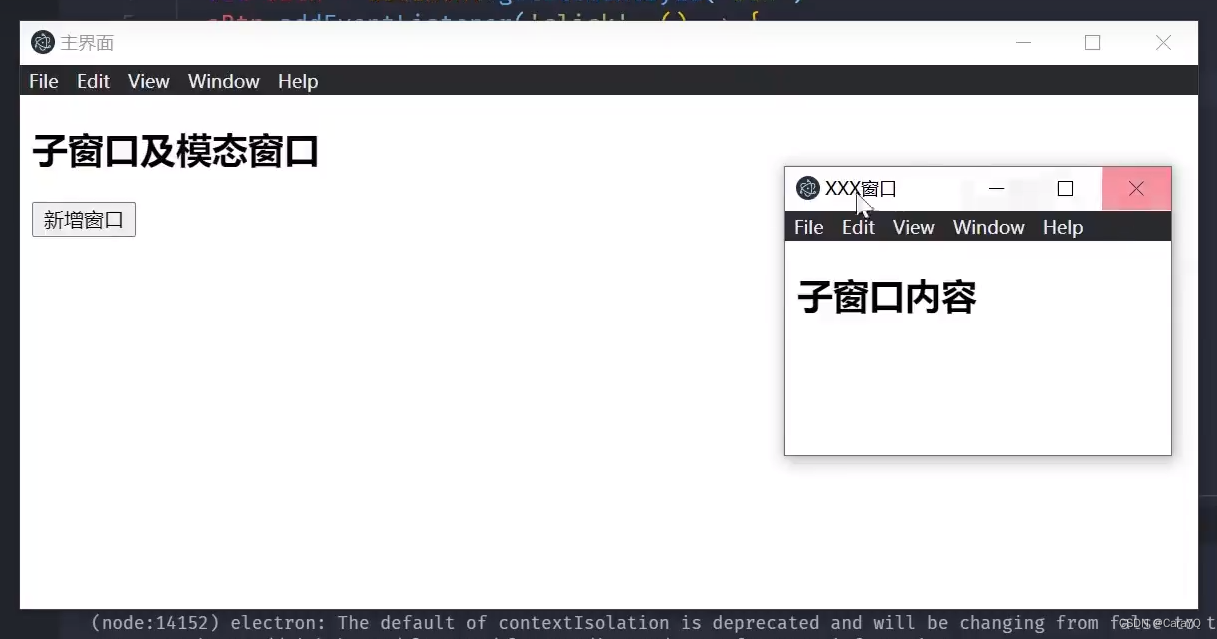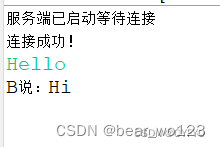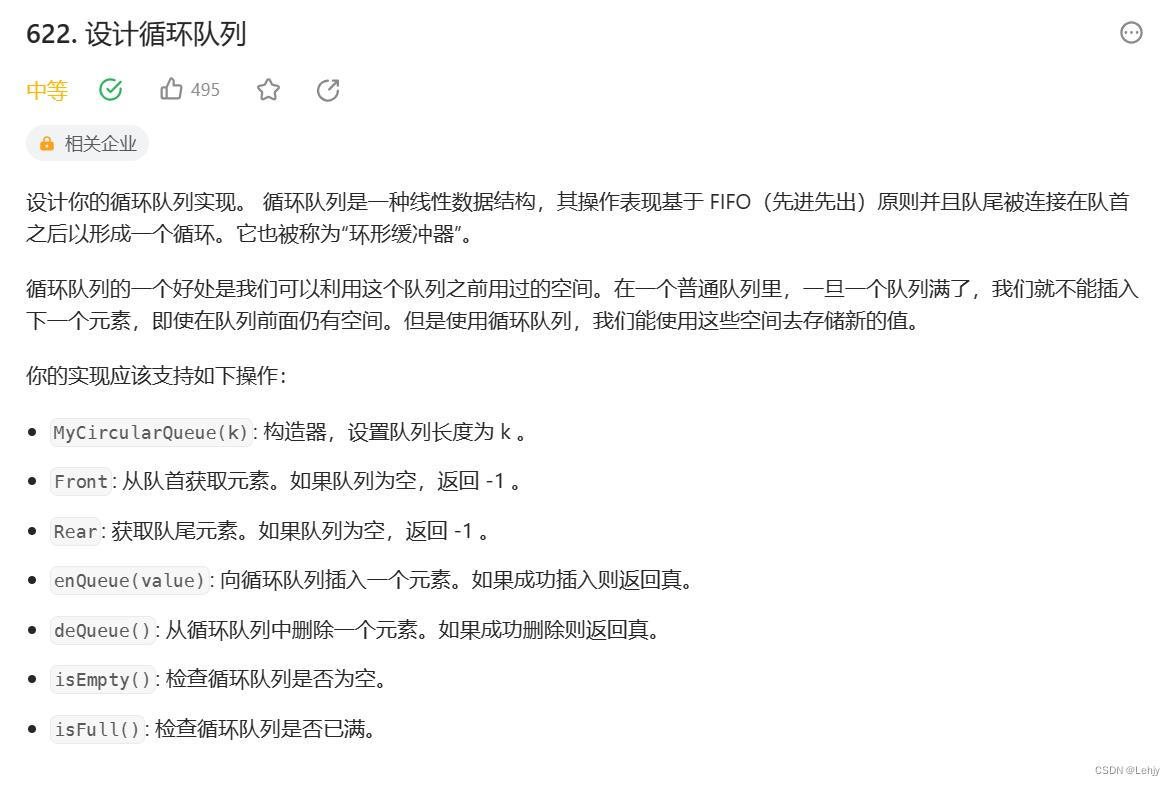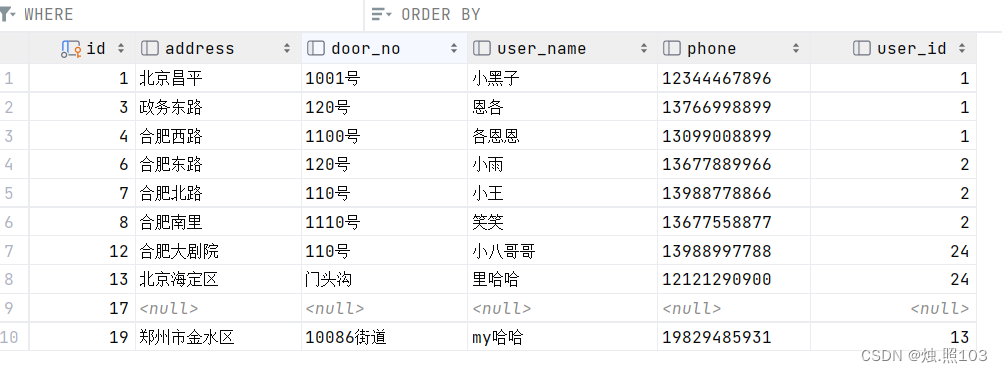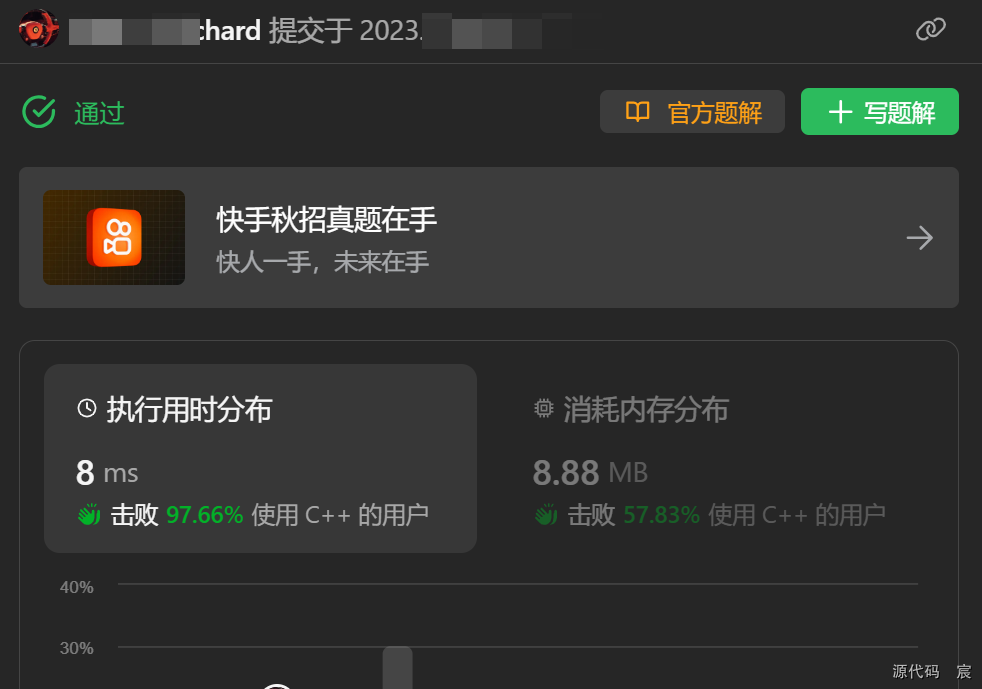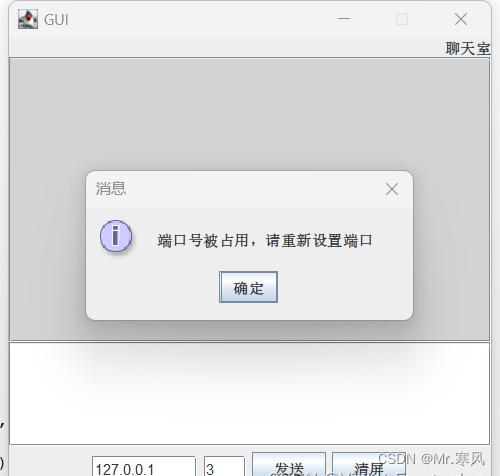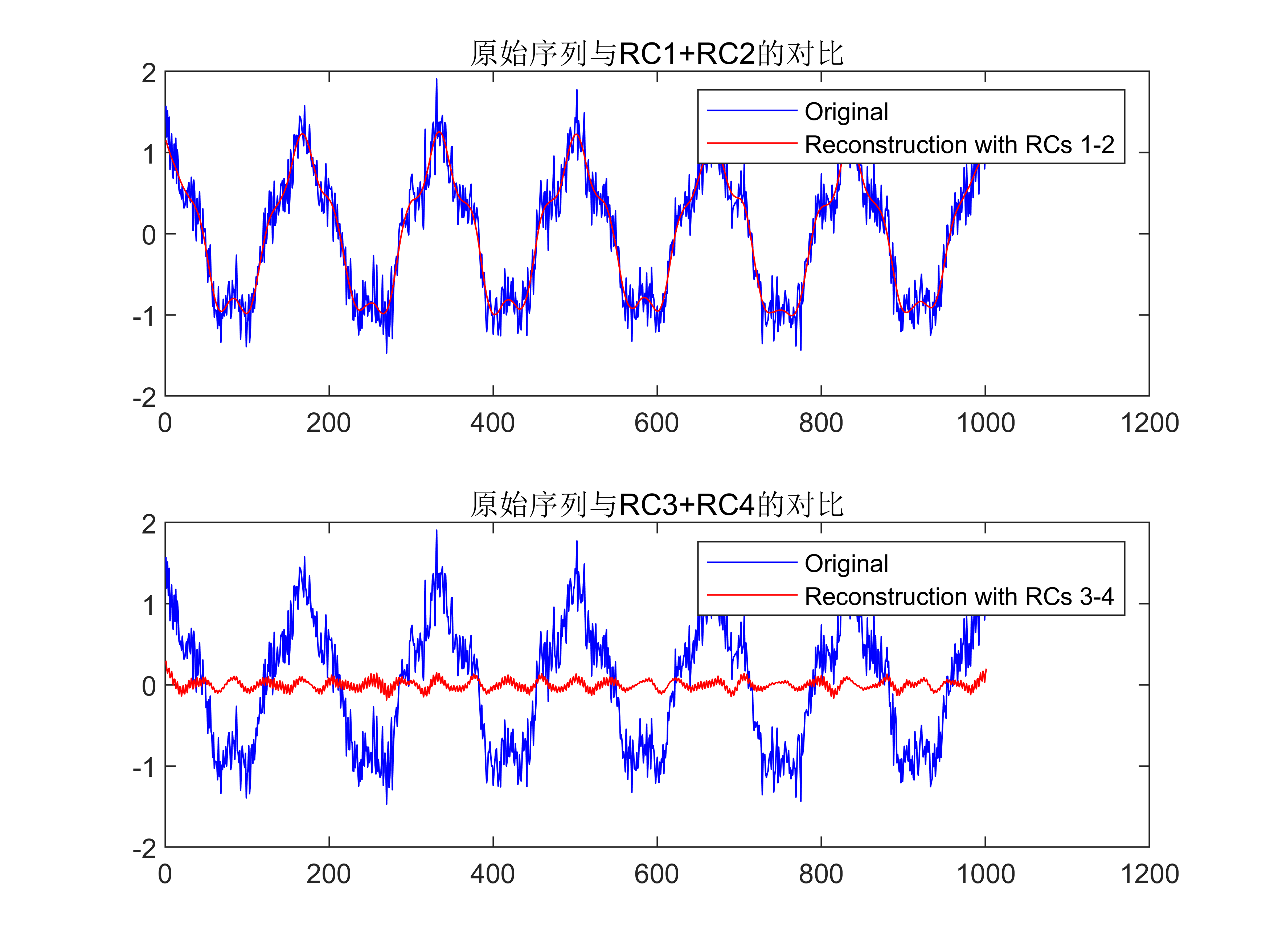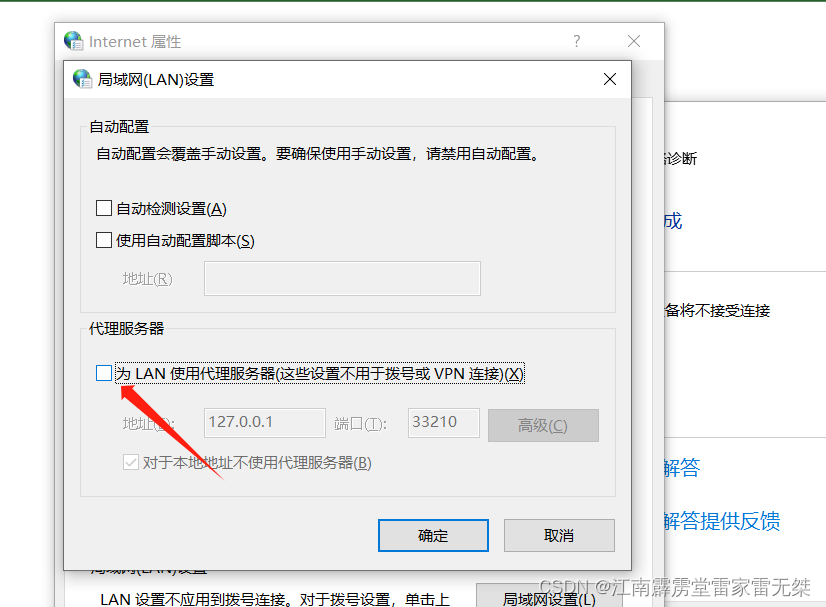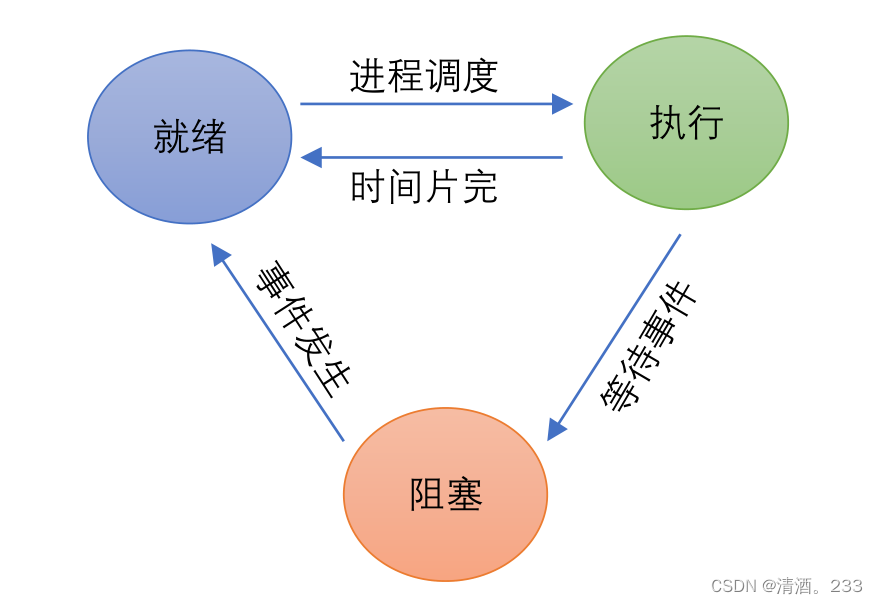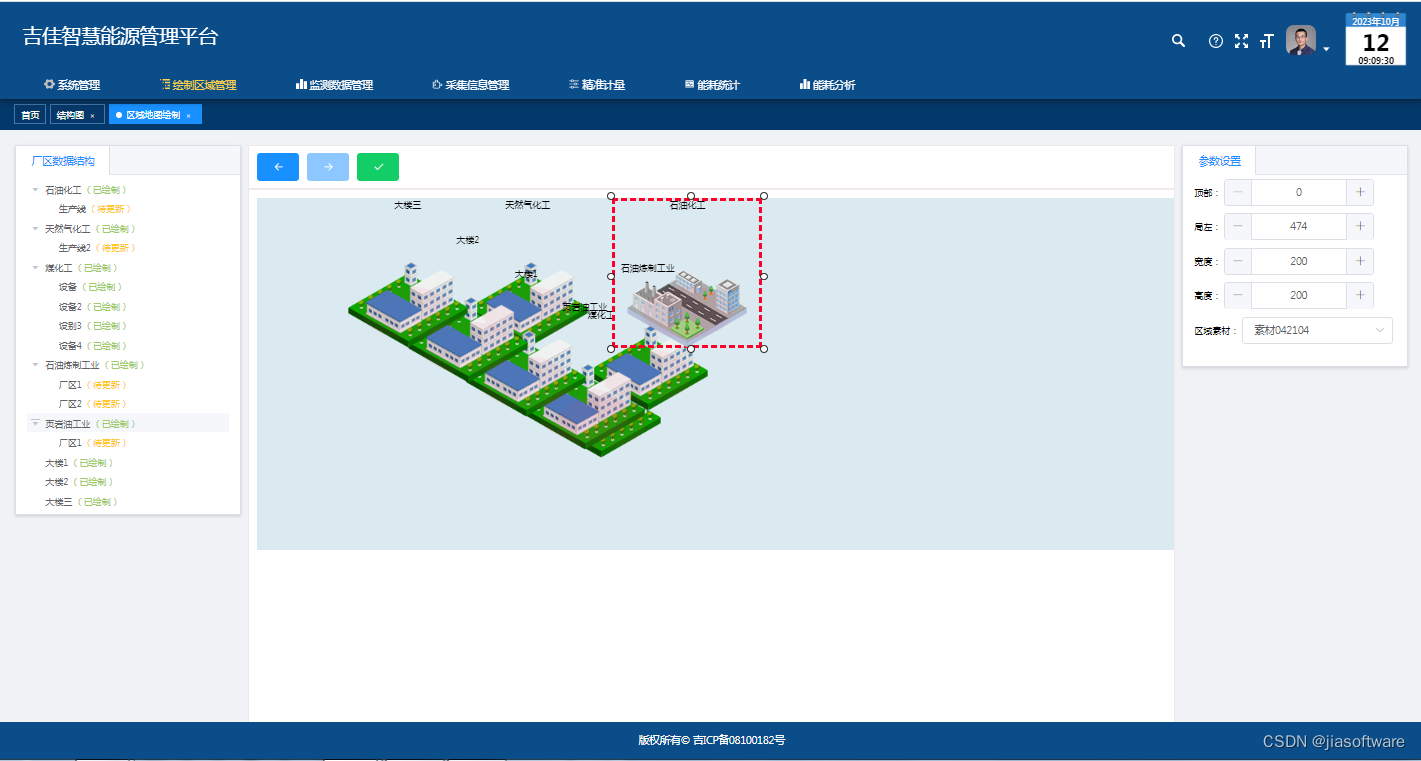一、泛型
1 泛型的理解和好处
1.1 看一个需求
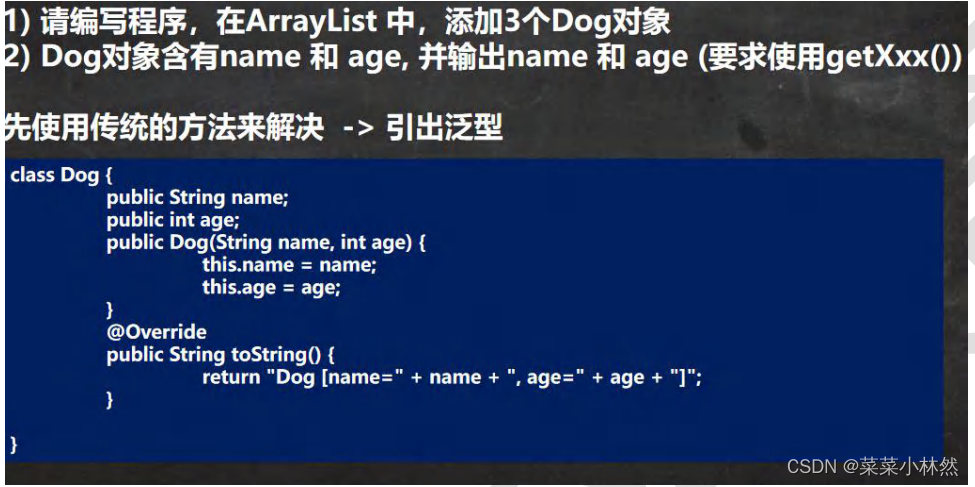
【不小心加入其它类型,会导致出现类型转换异常】
package com.hspedu.generic;import java.util.ArrayList;/*** @author 林然* @version 1.0*/
public class Generic01 {@SuppressWarnings("all")public static void main(String[] args) {ArrayList arrayList =new ArrayList();arrayList.add(new Dog("旺财", 10));arrayList.add(new Dog("发财", 1));arrayList.add(new Dog("小黄", 5));//假如我们的程序员,不小心,添加了一只猫arrayList.add(new Cat("招财猫", 8));for (Object o:arrayList) {Dog o1= (Dog) o;System.out.println(o1.getName() + "-" + o1.getAge());}}
}
/*
请编写程序,在ArrayList 中,添加3个Dog对象
Dog对象含有name 和 age, 并输出name 和 age (要求使用getXxx())*/
class Dog {private String name;private int age;public Dog(String name, int age) {this.name = name;this.age = age;}public String getName() {return name;}public void setName(String name) {this.name = name;}public int getAge() {return age;}public void setAge(int age) {this.age = age;}
}class Cat { //Cat类private String name;private int age;public Cat(String name, int age) {this.name = name;this.age = age;}public String getName() {return name;}public void setName(String name) {this.name = name;}public int getAge() {return age;}public void setAge(int age) {this.age = age;}
}
1.2 使用传统方法的问题分析

1.3 泛型快速体验-用泛型来解决前面的问题

- 当我们 ArrayList<Dog> 表示存放到 ArrayList 集合中的元素是Dog类型 (细节后面说...)
- 如果编译器发现添加的类型,不满足要求,就会报错
- 在遍历的时候,可以直接取出 Dog 类型而不是 Object
- public class ArrayList<E> {} E称为泛型,那么 Dog->E
package com.hspedu.generic.improve;import java.util.ArrayList;/*** @author 林然* @version 1.0*/
public class Generic02 {@SuppressWarnings("all")public static void main(String[] args) {//使用传统的方法来解决===> 使用泛型//1. 当我们 ArrayList<Dog> 表示存放到 ArrayList 集合中的元素是Dog类型 (细节后面说...)//2. 如果编译器发现添加的类型,不满足要求,就会报错//3. 在遍历的时候,可以直接取出 Dog 类型而不是 Object//4. public class ArrayList<E> {} E称为泛型,那么 Dog->EArrayList <Dog>arrayList =new ArrayList<Dog>();arrayList.add(new Dog("旺财", 10));arrayList.add(new Dog("发财", 1));arrayList.add(new Dog("小黄", 5));//假如我们的程序员,不小心,添加了一只猫//arrayList.add(new Cat("招财猫", 8));System.out.println("===使用泛型====");for (Dog dog :arrayList){System.out.println(dog.getName() + "-" + dog.getAge());}}
}
/*
1.请编写程序,在ArrayList 中,添加3个Dog对象
2.Dog对象含有name 和 age, 并输出name 和 age (要求使用getXxx())
3.老师使用泛型来完成代码*/
class Dog {private String name;private int age;public Dog(String name, int age) {this.name = name;this.age = age;}public String getName() {return name;}public void setName(String name) {this.name = name;}public int getAge() {return age;}public void setAge(int age) {this.age = age;}
}class Cat { //Cat类private String name;private int age;public Cat(String name, int age) {this.name = name;this.age = age;}public String getName() {return name;}public void setName(String name) {this.name = name;}public int getAge() {return age;}public void setAge(int age) {this.age = age;}
}
2. 泛型的理解和好处

3 泛型介绍
【可以表示数据类型的一种数据类型】


package com.hspedu.generic;/*** @author 林然* @version 1.0*/
public class Generic03 {public static void main(String[] args) {//注意,特别强调: E具体的数据类型在定义Person对象的时候指定,即在编译期间,就确定E是什么类型Person<String> person = new Person<String>("林然");Person<Integer> person2 = new Person<Integer>(100);person2.show();//Integer/*class Person {Integer s ;//E表示 s的数据类型, 该数据类型在定义Person对象的时候指定,即在编译期间,就确定E是什么类型public Person(Integer s) {//E也可以是参数类型this.s = s;}public Integer f() {//返回类型使用Ereturn s;}}*/}
}
//泛型的作用是:可以在类声明时通过一个标识表示类中某个属性的类型,
// 或者是某个方法的返回值的类型,或者是参数类型
class Person<E> {E s ;//E表示 s的数据类型, 该数据类型在定义Person对象的时候指定,即在编译期间,就确定E是什么类型public Person(E s) {//E也可以是参数类型this.s = s;}public E f() {//返回类型使用Ereturn s;}public void show() {System.out.println(s.getClass());//显示s的运行类型}
}二、 泛型的语法
1 泛型的声明

2 泛型的实例化

3 泛型使用举例

package com.hspedu.generic;import java.util.*;/*** @author 林然* @version 1.0*/
public class GenericExercise {@SuppressWarnings("all")public static void main(String[] args) {HashSet<Student> students = new HashSet<Student>();students.add(new Student("jack", 18));students.add(new Student("tom", 28));students.add(new Student("mary", 19));//遍历for (Student student : students) {System.out.println(student);}//使用泛型方式给HashMap 放入3个学生对象//K -> String V->StudentHashMap<String,Student> hm = new HashMap<String, Student>();/*public class HashMap<K,V> {}*/hm.put("milan", new Student("milan", 38));hm.put("smith", new Student("smith", 48));hm.put("hsp", new Student("hsp", 28));//迭代器 EntrySet/*public Set<Map.Entry<K,V>> entrySet() {Set<Map.Entry<K,V>> es;return (es = entrySet) == null ? (entrySet = new EntrySet()) : es;}*/Set<Map.Entry<String, Student>> entries = hm.entrySet();/*public final Iterator<Map.Entry<K,V>> iterator() {return new EntryIterator();}*/Iterator<Map.Entry<String, Student>> iterator = entries.iterator();while (iterator.hasNext()){Map.Entry<String, Student> next = iterator.next();System.out.println(next.getKey() + "-" + next.getValue());}}
}
/*** 创建 3个学生对象* 放入到HashSet中学生对象, 使用.* 放入到 HashMap中,要求 Key 是 String name, Value 就是 学生对象* 使用两种方式遍历*/
class Student {private String name;private int age;public Student(String name, int age) {this.name = name;this.age = age;}public String getName() {return name;}public void setName(String name) {this.name = name;}public int getAge() {return age;}public void setAge(int age) {this.age = age;}@Overridepublic String toString() {return "Student{" +"name='" + name + '\'' +", age=" + age +'}';}
}4 泛型使用的注意事项和细节
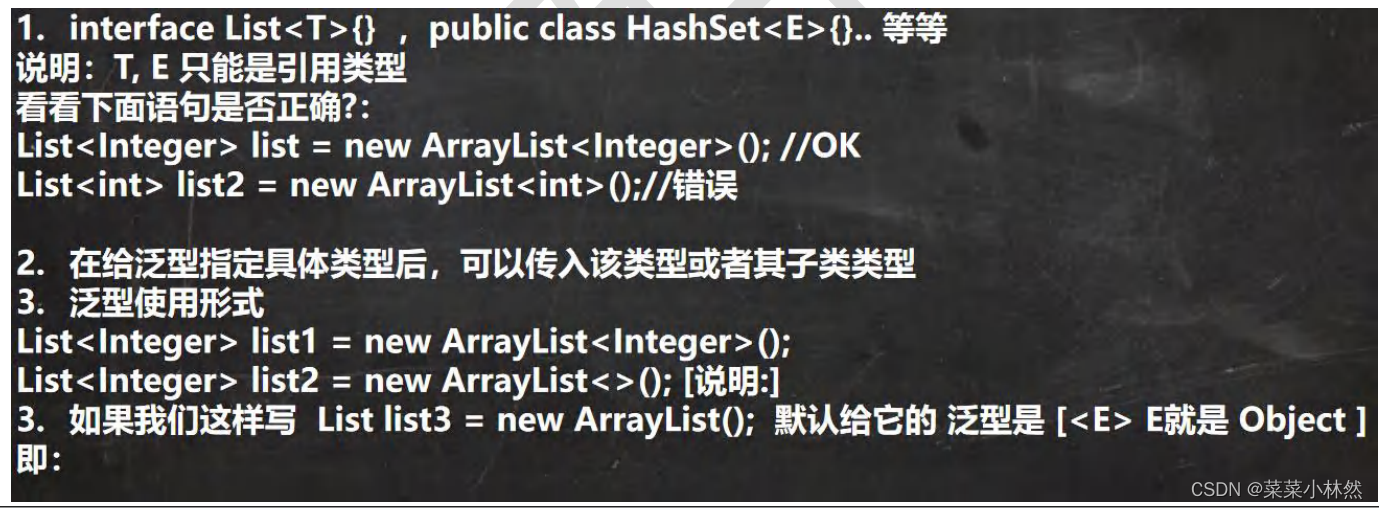
package com.hspedu.generic;import java.util.ArrayList;
import java.util.List;/*** @author 林然* @version 1.0*/
public class GenericDetail {@SuppressWarnings("all")public static void main(String[] args) {//1.给泛型指向数据类型是,要求是引用类型,不能是基本数据类型List<Integer> list = new ArrayList<Integer>(); //OK//List<int> list2 = new ArrayList<int>();//错误//2.//因为 E 指定了 A 类型, 构造器传入了 new A()//在给泛型指定具体类型后,可以传入该类型或者其子类类型Pig<A> aPig = new Pig<A>(new A());aPig.f();Pig<A> aPig1 = new Pig<>(new B());aPig1.f();//3. 泛型的使用形式ArrayList<Integer> list1 = new ArrayList<Integer>();List<Integer> list2 = new ArrayList<Integer>();//在实际开发中,我们往往简写//编译器会进行类型推断, 老师推荐使用下面写法ArrayList<Integer> list3 = new ArrayList<>();List<Integer> list4 = new ArrayList<>();ArrayList<Pig> pigs = new ArrayList<>();//4. 如果是这样写 泛型默认是 ObjectArrayList arrayList = new ArrayList();//等价 ArrayList<Object> arrayList = new ArrayList<Object>();/*public boolean add(Object e) {ensureCapacityInternal(size + 1); // Increments modCount!!elementData[size++] = e;return true;}*/Tiger tiger = new Tiger();/*class Tiger {//类Object e;public Tiger() {}public Tiger(Object e) {this.e = e;}}*/}
}
class Tiger<E> {//类E e;public Tiger() {}public Tiger(E e) {this.e = e;}
}class A {}
class B extends A {}class Pig<E> {//E e;public Pig(E e) {this.e = e;}public void f() {System.out.println(e.getClass()); //运行类型}
}
三、泛型课堂类型

package com.hspedu.generic;import java.util.ArrayList;
import java.util.Comparator;/*** @author 林然* @version 1.0*/
public class GenericExercise02 {public static void main(String[] args) {ArrayList<Employee> employees = new ArrayList<>();employees.add(new Employee("tom", 20000, new MyDate(1980,12,11)));employees.add(new Employee("jack", 12000, new MyDate(2001,12,12)));employees.add(new Employee("tom", 50000, new MyDate(1980,12,10)));System.out.println("employees=" + employees);employees.sort(new Comparator<Employee>() {@Overridepublic int compare(Employee emp1, Employee emp2) {//先按照name排序,如果name相同,则按生日日期的先后排序。【即:定制排序】//先对传入的参数进行验证if(!(emp1 instanceof Employee && emp2 instanceof Employee)) {System.out.println("类型不正确..");return 0;}//比较nameint i = emp1.getName().compareTo(emp2.getName());if(i != 0) {return i;}//下面是对birthday的比较,因此,我们最好把这个比较,放在MyDate类完成//封装后,将来可维护性和复用性,就大大增强.return emp1.getBirthday().compareTo(emp2.getBirthday());}});System.out.println("employees=" + employees);}
}
class Employee{private String name;private double sal;private MyDate birthday;public Employee(String name, double sal, MyDate birthday) {this.name = name;this.sal = sal;this.birthday = birthday;}public String getName() {return name;}public void setName(String name) {this.name = name;}public double getSal() {return sal;}public void setSal(double sal) {this.sal = sal;}public MyDate getBirthday() {return birthday;}public void setBirthday(MyDate birthday) {this.birthday = birthday;}@Overridepublic String toString() {return "\nEmployee{" +"name='" + name + '\'' +", sal=" + sal +", birthday=" + birthday +'}';}
}
class MyDate implements Comparable<MyDate>{private int year;private int month;private int day;@Overridepublic String toString() {return "MyDate{" +"year=" + year +", month=" + month +", day=" + day +'}';}public MyDate(int year, int month, int day) {this.year = year;this.month = month;this.day = day;}public int getYear() {return year;}public void setYear(int year) {this.year = year;}public int getMonth() {return month;}public void setMonth(int month) {this.month = month;}public int getDay() {return day;}public void setDay(int day) {this.day = day;}@Overridepublic int compareTo(MyDate o) { //把对year-month-day比较放在这里int yearMinus = year - o.getYear();if(yearMinus != 0) {return yearMinus;}//如果year相同,就比较monthint monthMinus = month - o.getMonth();if(monthMinus != 0) {return monthMinus;}//如果year 和 monthreturn day - o.getDay();}
}
四、自定义泛型
1 自定义泛型类 (难度)
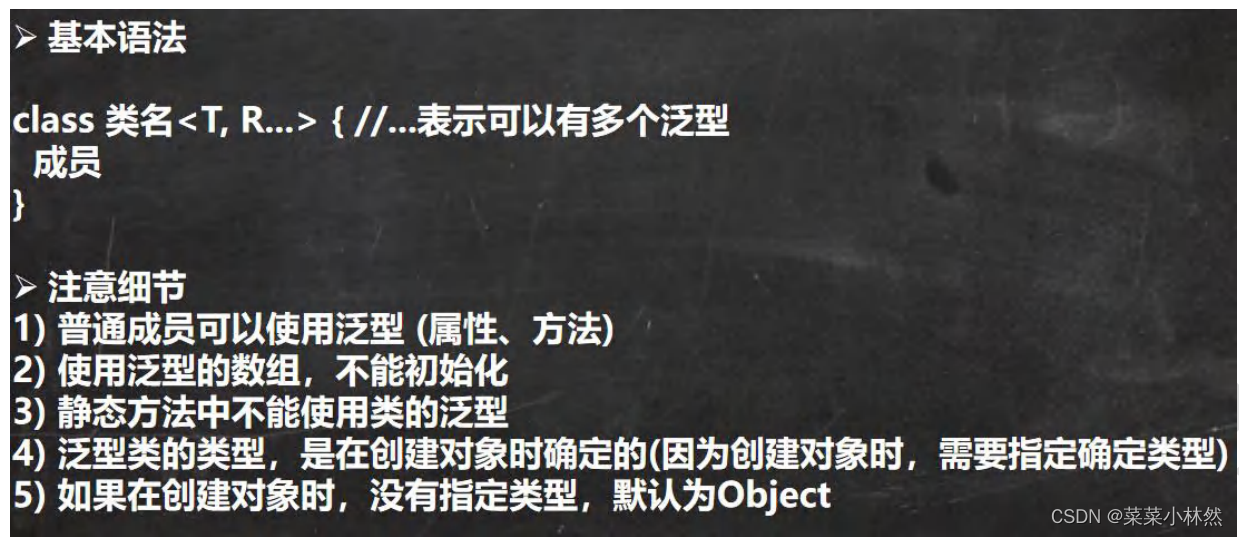

package com.hspedu.customgeneric;import java.util.Arrays;/*** @author 林然* @version 1.0*/
public class CustomGeneric_ {@SuppressWarnings("all")public static void main(String[] args) {//T=Double, R=String, M=IntegerTiger<Double,String,Integer> g = new Tiger<>("john");g.setT(10.9); //OK//g.setT("yy"); //错误,类型不对System.out.println(g);Tiger g2 = new Tiger("john~~");//OK T=Object R=Object M=Objectg2.setT("yy"); //OK ,因为 T=Object "yy"=String 是Object子类System.out.println("g2=" + g2);}
}//1. Tiger 后面泛型,所以我们把 Tiger 就称为自定义泛型类
//2, T, R, M 泛型的标识符, 一般是单个大写字母
//3. 泛型标识符可以有多个.
//4. 普通成员可以使用泛型 (属性、方法)
//5. 使用泛型的数组,不能初始化
//6. 静态方法中不能使用类的泛型
class Tiger<T, R, M> {String name;R r; //属性使用到泛型M m;T t;//因为数组在new 不能确定T的类型,就无法在内存开空间T[] ts;public Tiger(String name) {this.name = name;}public Tiger(R r, M m, T t) {//构造器使用泛型this.r = r;this.m = m;this.t = t;}public Tiger(String name, R r, M m, T t) {//构造器使用泛型this.name = name;this.r = r;this.m = m;this.t = t;}//因为静态是和类相关的,在类加载时,对象还没有创建//所以,如果静态方法和静态属性使用了泛型,JVM就无法完成初始化
// static R r2;
// public static void m1(M m) {
//
// }//方法使用泛型public String getName() {return name;}public void setName(String name) {this.name = name;}public R getR() {return r;}public void setR(R r) {//方法使用到泛型this.r = r;}public M getM() {//返回类型可以使用泛型.return m;}public void setM(M m) {this.m = m;}public T getT() {return t;}public void setT(T t) {this.t = t;}@Overridepublic String toString() {return "Tiger{" +"name='" + name + '\'' +", r=" + r +", m=" + m +", t=" + t +", ts=" + Arrays.toString(ts) +'}';}
}
2 自定义泛型接口

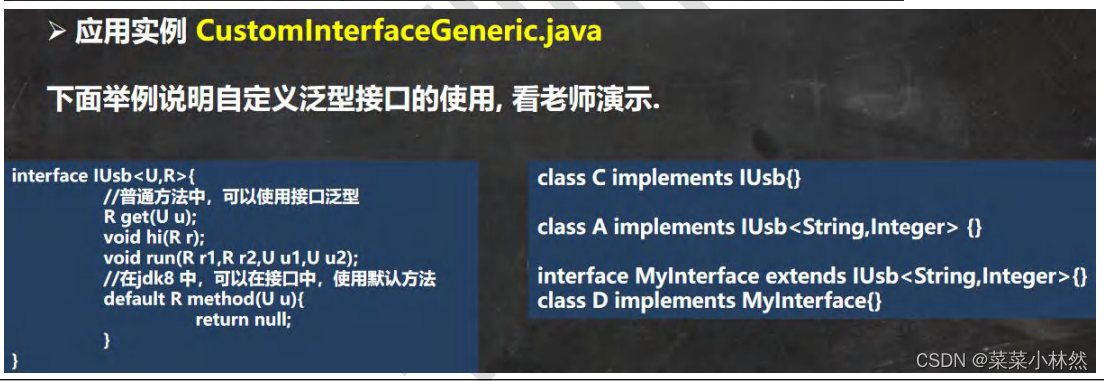
package com.hspedu.customgeneric;/*** @author 林然* @version 1.0*/
public class CustomInterfaceGeneric {public static void main(String[] args) {}
}
/*** 泛型接口使用的说明* 1. 接口中,静态成员也不能使用泛型* 2. 泛型接口的类型, 在继承接口或者实现接口时确定* 3. 没有指定类型,默认为Object*/
//在继承接口 指定泛型接口的类型
interface IA extends IUsb<String, Double> {}
//当我们去实现IA接口时,因为IA在继承IUsu 接口时,指定了U 为String R为Double
//,在实现IUsu接口的方法时,使用String替换U, 是Double替换R
class AA implements IA {@Overridepublic Double get(String s) {return null;}@Overridepublic void hi(Double aDouble) {}@Overridepublic void run(Double r1, Double r2, String u1, String u2) {}
}//实现接口时,直接指定泛型接口的类型
//给U 指定Integer 给 R 指定了 Float
//所以,当我们实现IUsb方法时,会使用Integer替换U, 使用Float替换R
class BB implements IUsb<Integer, Float> {@Overridepublic Float get(Integer integer) {return null;}@Overridepublic void hi(Float aFloat) {}@Overridepublic void run(Float r1, Float r2, Integer u1, Integer u2) {}
}
//没有指定类型,默认为Object
//建议直接写成 IUsb<Object,Object>
class CC implements IUsb { //等价 class CC implements IUsb<Object,Object> {@Overridepublic Object get(Object o) {return null;}@Overridepublic void hi(Object o) {}@Overridepublic void run(Object r1, Object r2, Object u1, Object u2) {}}
interface IUsb<U, R> {int n = 10;//U name; 不能这样使用//普通方法中,可以使用接口泛型R get(U u);void hi(R r);void run(R r1, R r2, U u1, U u2);//在jdk8 中,可以在接口中,使用默认方法, 也是可以使用泛型default R method(U u) {return null;}
}
3 自定义泛型方法
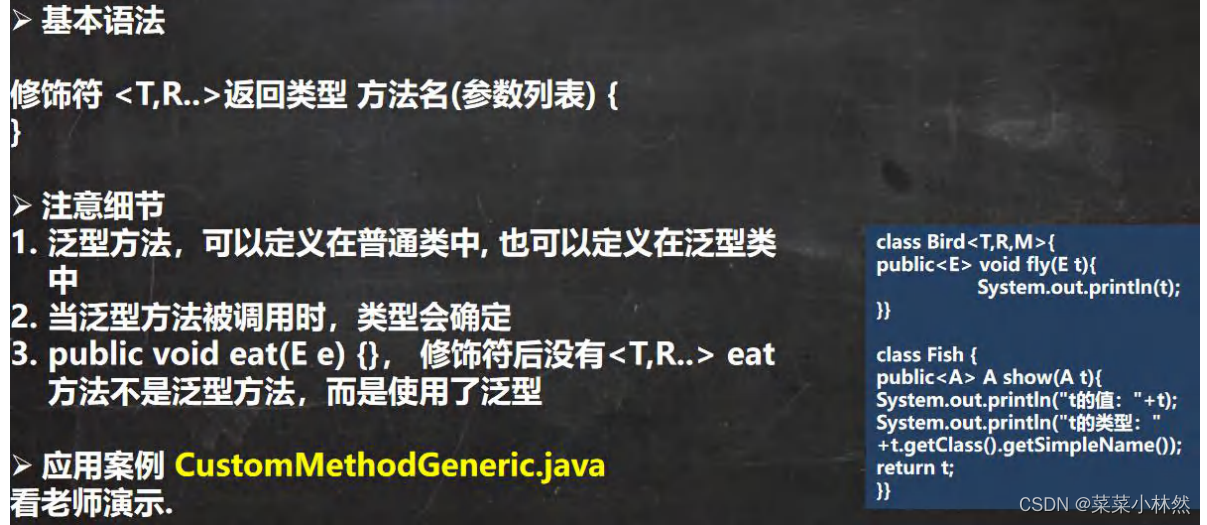
package com.hspedu.customgeneric;import java.util.ArrayList;/*** @author 林然* @version 1.0*/
public class CustomMethodGeneric {public static void main(String[] args) {Car car = new Car();car.fly("宝马", 100);//当调用方法时,传入参数,编译器,就会确定类型System.out.println("=======");car.fly(300, 100.1);//当调用方法时,传入参数,编译器,就会确定类型//测试//T->String, R-> ArrayListFish<String, ArrayList> fish = new Fish<>();fish.hello(new ArrayList(), 11.3f);}
}
//泛型方法,可以定义在普通类中, 也可以定义在泛型类中
class Car {//普通类public void run() {//普通方法}//说明 泛型方法//1. <T,R> 就是泛型//2. 是提供给 fly使用的public <T, R> void fly(T t, R r) {//泛型方法System.out.println(t.getClass());//StringSystem.out.println(r.getClass());//Integer}
}
class Fish<T, R> {//泛型类public void run() {//普通方法}public<U,M> void eat(U u, M m) {//泛型方法}//说明//1. 下面hi方法不是泛型方法//2. 是hi方法使用了类声明的 泛型public void hi(T t) {}//泛型方法,可以使用类声明的泛型,也可以使用自己声明泛型public<K> void hello(R r, K k) {System.out.println(r.getClass());//ArrayListSystem.out.println(k.getClass());//Float}}
4 自定义泛型方法

五、泛型的继承和通配符
1 泛型的继承和通配符说明

2 应用案例
package com.hspedu;import java.util.ArrayList;
import java.util.List;public class GenericExtends {public static void main(String[] args) {Object o = new String("xx");//泛型没有继承性//List<Object> list = new ArrayList<String>();//举例说明下面三个方法的使用List<Object> list1 = new ArrayList<>();List<String> list2 = new ArrayList<>();List<AA> list3 = new ArrayList<>();List<BB> list4 = new ArrayList<>();List<CC> list5 = new ArrayList<>();//如果是 List<?> c ,可以接受任意的泛型类型printCollection1(list1);printCollection1(list2);printCollection1(list3);printCollection1(list4);printCollection1(list5);//List<? extends AA> c: 表示 上限,可以接受 AA或者AA子类
// printCollection2(list1);//×
// printCollection2(list2);//×printCollection2(list3);//√printCollection2(list4);//√printCollection2(list5);//√//List<? super AA> c: 支持AA类以及AA类的父类,不限于直接父类printCollection3(list1);//√//printCollection3(list2);//×printCollection3(list3);//√//printCollection3(list4);//×//printCollection3(list5);//×//冒泡排序//插入排序//....}// ? extends AA 表示 上限,可以接受 AA或者AA子类public static void printCollection2(List<? extends AA> c) {for (Object object : c) {System.out.println(object);}}//说明: List<?> 表示 任意的泛型类型都可以接受public static void printCollection1(List<?> c) {for (Object object : c) { // 通配符,取出时,就是ObjectSystem.out.println(object);}}// ? super 子类类名AA:支持AA类以及AA类的父类,不限于直接父类,//规定了泛型的下限public static void printCollection3(List<? super AA> c) {for (Object object : c) {System.out.println(object);}}}class AA {
}class BB extends AA {
}class CC extends BB {
}六、本章作业

package com.hspedu.homework;import org.junit.jupiter.api.Test;import java.util.List;public class Homework01 {public static void main(String[] args) {}@Testpublic void testList() {//说明//这里我们给T 指定类型是UserDAO<User> dao = new DAO<>();dao.save("001", new User(1,10,"jack"));dao.save("002", new User(2,18,"king"));dao.save("003", new User(3,38,"smith"));List<User> list = dao.list();System.out.println("list=" + list);dao.update("003", new User(3, 58, "milan"));dao.delete("001");//删除System.out.println("===修改后====");list = dao.list();System.out.println("list=" + list);System.out.println("id=003 " + dao.get("003"));//milan}
}
/*** 定义个泛型类 DAO<T>,在其中定义一个Map 成员变量,Map 的键为 String 类型,值为 T 类型。** 分别创建以下方法:* (1) public void save(String id,T entity): 保存 T 类型的对象到 Map 成员变量中* (2) public T get(String id):从 map 中获取 id 对应的对象* (3) public void update(String id,T entity):替换 map 中key为id的内容,改为 entity 对象* (4) public List<T> list():返回 map 中存放的所有 T 对象* (5) public void delete(String id):删除指定 id 对象** 定义一个 User 类:* 该类包含:private成员变量(int类型) id,age;(String 类型)name。** 创建 DAO 类的对象, 分别调用其 save、get、update、list、delete 方法来操作 User 对象,* 使用 Junit 单元测试类进行测试。** 思路分析* 1. 定义User类* 2. 定义Dao<T>泛型类*/
package com.hspedu.homework;import java.util.*;/*** * 定义个泛型类 DAO<T>,在其中定义一个Map 成员变量,Map 的键为 String 类型,值为 T 类型。* ** * 分别创建以下方法:* * (1) public void save(String id,T entity): 保存 T 类型的对象到 Map 成员变量中* * (2) public T get(String id):从 map 中获取 id 对应的对象* * (3) public void update(String id,T entity):替换 map 中key为id的内容,改为 entity 对象* * (4) public List<T> list():返回 map 中存放的所有 T 对象* * (5) public void delete(String id):删除指定 id 对象*/
public class DAO<T> {//泛型类private Map<String, T> map = new HashMap<>();public T get(String id) {return map.get(id);}public void update(String id,T entity) {map.put(id, entity);}//返回 map 中存放的所有 T 对象//遍历map [k-v],将map的 所有value(T entity),封装到ArrayList返回即可public List<T> list() {//创建 ArraylistList<T> list = new ArrayList<>();//遍历mapSet<String> keySet = map.keySet();for (String key : keySet) {//map.get(key) 返回就是 User对象->ArrayListlist.add(map.get(key));//也可以直接使用本类的 get(String id)}return list;}public void delete(String id) {map.remove(id);}public void save(String id,T entity) {//把entity保存到mapmap.put(id, entity);}}
package com.hspedu.homework;/*** * 该类包含:private成员变量(int类型) id,age;(String 类型)name*/
public class User {private int id;private int age;private String name;public User(int id, int age, String name) {this.id = id;this.age = age;this.name = name;}public int getId() {return id;}public void setId(int id) {this.id = id;}public int getAge() {return age;}public void setAge(int age) {this.age = age;}public String getName() {return name;}public void setName(String name) {this.name = name;}@Overridepublic String toString() {return "User{" +"id=" + id +", age=" + age +", name='" + name + '\'' +'}';}
}
七、JUnit
1 为什么需要 JUnit

2 基本介绍

package com.hspedu.junit_;import org.junit.jupiter.api.Test;public class JUnit_ {public static void main(String[] args) {//传统方式//new JUnit_().m1();//new JUnit_().m2();}@Testpublic void m1() {System.out.println("m1方法被调用");}@Testpublic void m2() {System.out.println("m2方法被调用");}@Testpublic void m3() {System.out.println("m3方法被调用");}
}
